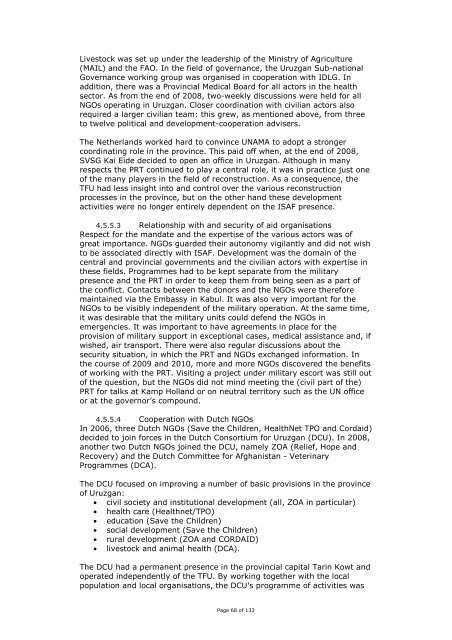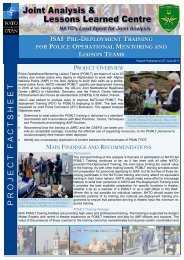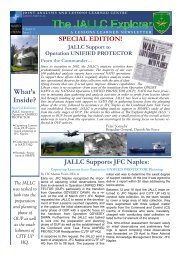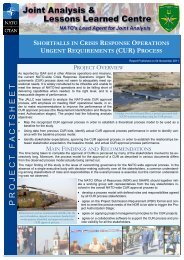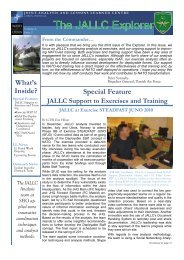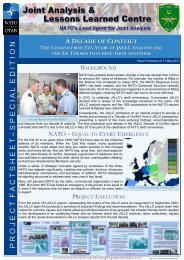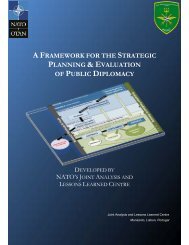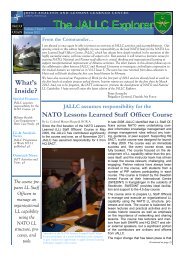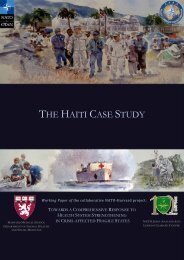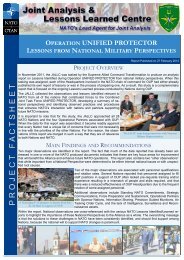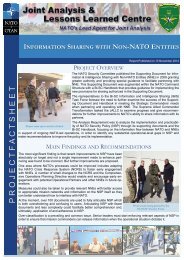Final evaluation Netherlands participation in ISAF 2006 - 2010
Final evaluation Netherlands participation in ISAF 2006 - 2010
Final evaluation Netherlands participation in ISAF 2006 - 2010
Create successful ePaper yourself
Turn your PDF publications into a flip-book with our unique Google optimized e-Paper software.
Livestock was set up under the leadership of the M<strong>in</strong>istry of Agriculture(MAIL) and the FAO. In the field of governance, the Uruzgan Sub-nationalGovernance work<strong>in</strong>g group was organised <strong>in</strong> cooperation with IDLG. Inaddition, there was a Prov<strong>in</strong>cial Medical Board for all actors <strong>in</strong> the healthsector. As from the end of 2008, two-weekly discussions were held for allNGOs operat<strong>in</strong>g <strong>in</strong> Uruzgan. Closer coord<strong>in</strong>ation with civilian actors alsorequired a larger civilian team: this grew, as mentioned above, from threeto twelve political and development-cooperation advisers.The <strong>Netherlands</strong> worked hard to conv<strong>in</strong>ce UNAMA to adopt a strongercoord<strong>in</strong>at<strong>in</strong>g role <strong>in</strong> the prov<strong>in</strong>ce. This paid off when, at the end of 2008,SVSG Kai Eide decided to open an office <strong>in</strong> Uruzgan. Although <strong>in</strong> manyrespects the PRT cont<strong>in</strong>ued to play a central role, it was <strong>in</strong> practice just oneof the many players <strong>in</strong> the field of reconstruction. As a consequence, theTFU had less <strong>in</strong>sight <strong>in</strong>to and control over the various reconstructionprocesses <strong>in</strong> the prov<strong>in</strong>ce, but on the other hand these developmentactivities were no longer entirely dependent on the <strong>ISAF</strong> presence.4.5.5.3 Relationship with and security of aid organisationsRespect for the mandate and the expertise of the various actors was ofgreat importance. NGOs guarded their autonomy vigilantly and did not wishto be associated directly with <strong>ISAF</strong>. Development was the doma<strong>in</strong> of thecentral and prov<strong>in</strong>cial governments and the civilian actors with expertise <strong>in</strong>these fields. Programmes had to be kept separate from the militarypresence and the PRT <strong>in</strong> order to keep them from be<strong>in</strong>g seen as a part ofthe conflict. Contacts between the donors and the NGOs were thereforema<strong>in</strong>ta<strong>in</strong>ed via the Embassy <strong>in</strong> Kabul. It was also very important for theNGOs to be visibly <strong>in</strong>dependent of the military operation. At the same time,it was desirable that the military units could defend the NGOs <strong>in</strong>emergencies. It was important to have agreements <strong>in</strong> place for theprovision of military support <strong>in</strong> exceptional cases, medical assistance and, ifwished, air transport. There were also regular discussions about thesecurity situation, <strong>in</strong> which the PRT and NGOs exchanged <strong>in</strong>formation. Inthe course of 2009 and <strong>2010</strong>, more and more NGOs discovered the benefitsof work<strong>in</strong>g with the PRT. Visit<strong>in</strong>g a project under military escort was still outof the question, but the NGOs did not m<strong>in</strong>d meet<strong>in</strong>g the (civil part of the)PRT for talks at Kamp Holland or on neutral territory such as the UN officeor at the governor’s compound.4.5.5.4 Cooperation with Dutch NGOsIn <strong>2006</strong>, three Dutch NGOs (Save the Children, HealthNet TPO and Cordaid)decided to jo<strong>in</strong> forces <strong>in</strong> the Dutch Consortium for Uruzgan (DCU). In 2008,another two Dutch NGOs jo<strong>in</strong>ed the DCU, namely ZOA (Relief, Hope andRecovery) and the Dutch Committee for Afghanistan - Veter<strong>in</strong>aryProgrammes (DCA).The DCU focused on improv<strong>in</strong>g a number of basic provisions <strong>in</strong> the prov<strong>in</strong>ceof Uruzgan:• civil society and <strong>in</strong>stitutional development (all, ZOA <strong>in</strong> particular)• health care (Healthnet/TPO)• education (Save the Children)• social development (Save the Children)• rural development (ZOA and CORDAID)• livestock and animal health (DCA).The DCU had a permanent presence <strong>in</strong> the prov<strong>in</strong>cial capital Tar<strong>in</strong> Kowt andoperated <strong>in</strong>dependently of the TFU. By work<strong>in</strong>g together with the localpopulation and local organisations, the DCU's programme of activities wasPage 68 of 133


